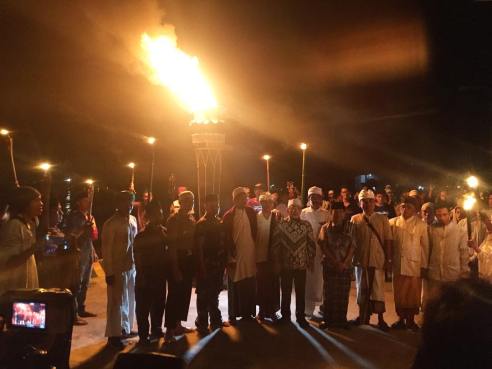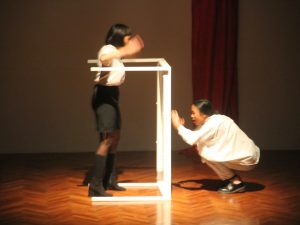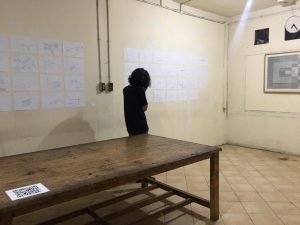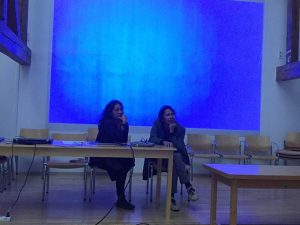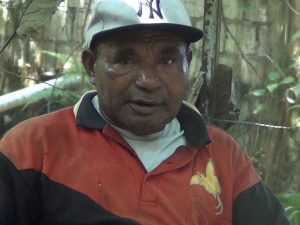The first Bangsal Menggawe was held in 2016 as part of the North Lombok AKUMASSA Chronicle Art Project. It raises “Membasaq” as its theme. On 2017, Bangsal Menggawe was held again with “Siq-Siq O Bungkuk” as its theme. The third festival, which should take place in 2018, was cancelled because the earthquake hit Lombok island. This year, the 3rd Bangsal Menggawe raised the “Museum of Tales” as its theme. This festival ran throughout February 2019 until its main event on March 2, 2019. In response to the post-earthquake situation during August 2018, a new format was used at this year’s festival. Bangsal Menggawe: Museum of Tales, as a festival, no longer invites artists from outside Pemenang to attend and produce certain works of art. Otty Widasari and Muhammad Sibawaihi as co-curators put their focus on efforts to reactivate the creative work (involving) of the peoples in Pemenang district after natural disasters. Such initiatives have existed in the two previous Bangsal Menggawe. But this time the initiative was sharpened by putting the invited artists as no longer facilitators. Instead, the artist will just help the local people to make their ideas come true. Bangsal Menggawe: Museum of Tales consists of several sustainable projects. Muhammad Imran (Aksara Tani) and Hamdani (Video Artist) who collaborated with Dhuha Ramadhani (Forum Lenteng) have launched Berugaq TV on Thursday, February 28, 2019. The project focuses on attempts to manage and activate the archives owned and produced by Yayasan Pasirputih and the people, in which particularly about Pemenang District, since 2010. The main pulse of this project is to develop and maintain media awareness especially in the aspects of production, co-production and distribution of knowledge. In the context of television as a medium, producing an alternative spectacle independently is a short-term goal to be achieved in this festival as a prefix to other advanced awareness. Two theatre artists, Martini Supiana and Muhammad Gozali, collaborate with performance artists, Pingkan Polla, making a project called Isin Angsat Theatre. In the local language, the words “isin angsat” are interpreted as everything brought by high tide and was left behind during the low tide. In material terms, it can be objects as well as coastal organisms that are sometimes valuable. This idea was then raised into the performance as a theme, which was performed in various spaces; starting from private space, semi-private space, closed public space, and open public space, in a sequential series with a continuously upgraded concept on each performance. Teater Isin Angsat tried to respond the daily lives of people in Pemenang through their eight numbers of performance. Drew them into the intersection between theater and performance art. Sometimes we take the existence of sound as simply natural and as if inexplicable. Even though it is in around us, only the presences of certain sounds provoke a certain response from us as listeners. However, the sound may actually be observed contextually. That its existence also relates to human activity, not only to the nature. To respond sound, some activists of Yayasan Pasirputih and the people around collaborated with Theo Nugraha in producing a zine entitled “The Sound of Pemenang” The zine consists of texts and sketches of sound that existed and located around the Pemenang District during the residency process of Bangsal Menggawe 2019. Lalu Mintarja, a citizen of Karang Desa, had the idea to make a giant trumpet. In his daily life after natural disaster hit the island of Lombok, especially in Pemenang District, North Lombok Regency which is one of the most impacted area by the earthquake, Mintarja has made about 40 earthquake resistant houses with bamboo as the main material. This activists of Gerbong Tua community is also active with young people who are engaged in social issues, including in art. His encounter with Maria Christina Silalahi bring his idea of making trumpet back into consideration. In the discussion about the material used in production, there came the idea of using bamboo as its structure and plastic bottles of drinking water as its case. We can also see Maria’s artistic tendencies here. By looking at her latest work “Di Sini Sudah Sedikit, Di Sana Masih Banyak,” we can see her consistency in addressing the problems that exist around the drinking water company. What distinguishes her current work and the previous one is the fact that plastic bottles are not considered as waste in Pemenang District but rather an economic value commodity. Mintarja gives a certain focus on sound itself. He wants to respond the sounds on the streets and the loudspeakers around his neighbourhood. They succeeded in making a giant trumpet called “Tapa Kelomang“. Bangsal Menggawe: Museum of Tales has also became a meeting point for AKUMASSA’s community network, Komunitas Gubuak Kopi (represented by Albert Rahman Putra and Joe Datuak) and including Yayasan Pasirputih itself. Meanwhile, after the many exercises in various places, such as at school and the government office, Zakaria and activists from Sanggar Panca Pesona held a mass gymnastics performance of Senam Tari Rudat on the east coast of Bangsal Harbor on Saturday, March 2, 2019. Gymnastics is used as their strategy in reviving the spirit of Rudat Dance to be closer to its people. In the afternoon, the final match of Bangsal Cup U-13 was held. Rajib Hari, who was the coordinator for Bangsal Cup this year, tried to provide a place for the young footballers in Pemenang District and its surroundings. In Bangsal Cup this year, the organizers made their own football field by utilizing a neglected land full of weeds. Through this year’s festival, Anggraeni Widhiasih has started her research project about the other face of economy. She wants to read it in the socio-cultural context of the society in Pemenang within the curatorial framework of Bangsal Menggawe. In curatorial frames, the artists who come from outside Pemenang are also required to finance themselves independently. This aspect is one of Anggraeni’s research objects. While Manshur Zikri, more broadly, will comprehend the whole project in a more theoretical viewpoint. In the post-earthquake situation, the main event of Bangsal Menggawe was not held in a march but gathering the people for mass prayer. People from Hinduism, Buddhism and Islam took their respective positions in the Bangsal Harbor and prayed led by each of their religious leaders. The prayer location is brightened by 1,000 torches made jointly by youths in Pemenang District facilitated by Komunitas Bale Kebon and Albert. After praying, all the people present walked together towards the pier. When Tapa Kelomang sounded, the community leaders raised their torches to light the Obor Beleq (great torch) which was a symbol of the strong relationship between people of Pemenang.*** Year North Lombok, Indonesia
2019
Bangsal Menggawe: Museum of Tales
